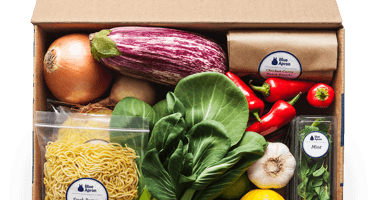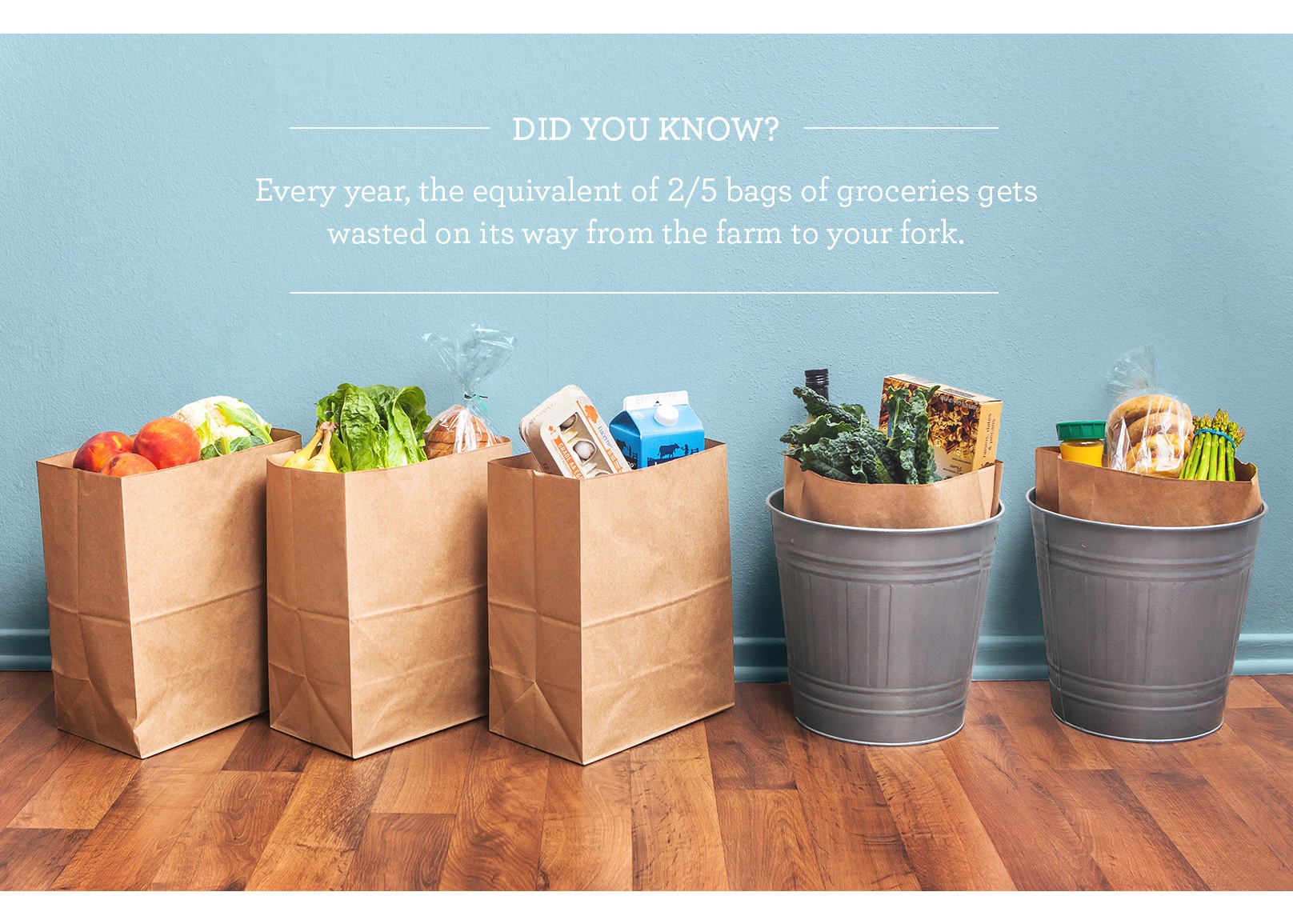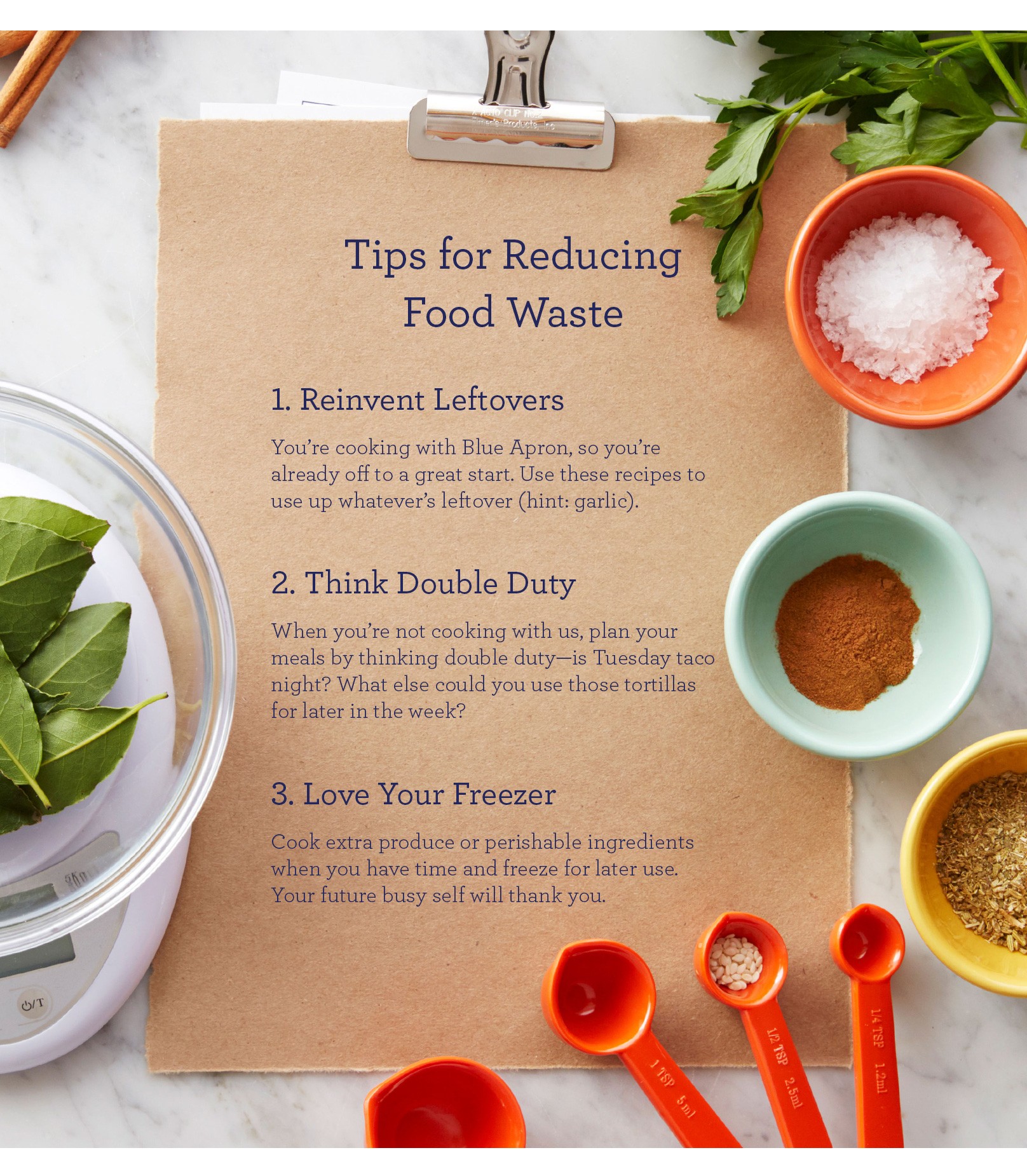Blue Apron: Delivering an efficient tomorrow

Blue Apron is building a business model on efficient supply chains to achieve a reduction in food waste, an increase in the use of local ingredients and a promotion of better eating habits.
Take a moment to think about the following facts1:
- Every year, consumers in industrialized countries waste almost as much food as the entire net food production of sub-Saharan Africa (222 million vs. 230 million tons)
- The amount of food lost and wasted every year is equal to more than half of the world’s annual cereals crops (2.3 billion tons in 2009/10)
- In the USA, 30-40% of the food supply is wasted, equaling more than 20 pounds of food per person per month
Now look at the following facts2:
- Around the world, 842 million people do not have enough of the food they need to live an active, healthy life.
- One in every eight people goes to bed hungry each night.
Somehow these two sets of facts do not align, and there is an obvious problem in getting the food that is supplied by the market to the people who demand it in a sustainable way.
Blue Apron is a company whose business model strives to solve this challenge in a profitable way. In the coming future, as the Earth’s resources are further strained to cater to higher demands, companies that produce and distribute food in efficient ways will become more important. Blue Apron delivers a box of fresh ingredients, straight to your door with easy to cook recipes and directions. The value proposition to the customer is the ease of takeout combined with the freshness of a home-cooked meal, all for a low price of $10 per meal3. There are a few ways that Blue Apron achieves this objective.
Reduction in food wastage: Ideally, whenever anyone cooks a salad, they can harvest half a tomato, a few lettuce leaves, two eggs from their household chicken, a few tablespoons of olive oil, half an avocado and two leaves of parsley. However, the reality is that customers have to buy more than what they need from a supermarket. In turn, the supermarket must procure more produce from distributors to keep their shelves stacked and provide options to their customers. In turn, the distributors must demand more from farmers to account for seasonal changes in supermarket ordering patterns. Each of these stages involves an enormous amount of overproduction, overstocking, and ultimately excess wastage. Blue Apron, on the other hand, delivers to the customer, the perfect amount of each ingredient required for cooking a specific meal serving. This reduces layers in the supply chain, and reduces the food wastage to a minimum.
Use of local ingredients: Blue Apron sources their raw ingredients directly from high quality local farms and suppliers, cutting out the middlemen and the wastage associated with high transportation distances4. This creates a lean supply chain, with just in time delivery directly to the consumers. The use of local ingredients reduces the carbon footprint and supports the local economy5. Going a step further, Blue Apron is actively supporting farmers who use regenerative farming practices that help build healthy soil for future generations6. This promotes a responsibility towards the natural resources that we have been blessed with on Earth, but have taken for granted since the industrial revolution.
Promotion of better eating habits: On the demand side, making cooking time, effort and cost efficient for consumers to cook fresh, healthy and high-quality meals at home promotes long-term sustainable eating habits. Since 1975, sugar consumption and obesity rates have skyrocketed, with obesity rates going from 10% to 60%7. As we become more aware of the long-term effects of healthy and unhealthy food consumption, our reliance on companies that promote healthy eating habits will only increase.
In conclusion, Blue Apron is a company that has set itself up for success and lasting impact as the effects of climate change become more and more pronounced.
(623 Words)
Sources:
1 http://www.worldfooddayusa.org/food_waste_the_facts
2 https://www.mercycorps.org/articles/quick-facts-what-you-need-know-about-global-hunger
4 https://www.blueapron.com/pages/meet-our-recent-partners
5 http://rodaleinstitute.org/why-local-food-is-better-for-you/
6 https://www.blueapron.com/pages/mission
7 https://www.ketovangelist.com/increased-sugar-and-obesity/
Images:
Cover Photo11 https://www.blueapron.com/pages/mission
Food wastage12 http://blog.blueapron.com/join-the-conversation-food-waste-in-america/
World hunger13 http://fbcgso.org/world-hunger-special-offering/






Hi, Aakash!
Really interesting text about Blue Apron. I have heard about the company even though I’m not a cooking fan.
I confess I didn’t know about their value proposition of reducing food waste. Indeed, this is a daily problem we face but we don’t actually realize its dimension.
The idea of selling the right size meal portion, at an accessible price is fantastic. I haven’t realized the responsibility I have as consumer: when I buy more than what I need from a supermarket not only I’m contributing for food wasting but also I’m perpetuating the pressure on the supply chain overproduction and overstocking
I like the idea of BA using their raw ingredients directly from local farms and suppliers; I wasn’t expecting such a sustainable consciousness from a startup that was launched just a few years ago. Sustainability sometimes can be costly and incorporate it in a business model can be quite challenging, but BA did it.
I really like this article from professor Jose B. Alvarez, where he discuss the food waste impact and how changing our conceptions on food might help reduce it: http://hbswk.hbs.edu/item/business-solutions-that-help-cut-food-waste
Good job, very interesting post Aakash!
While I think Blue Apron does a great job reducing food waste, they have a long way to go to make their meals more sustainable. First, 85% of their meals come from two distribution centers, which means a lot of emissions as a result of transportation.[1] Second, the packaging, while officially recyclable, is actually pretty hard to recycle. The plastic bags are all recyclable, but not of the sort that can be picked up for curbside [2]. The ice packs have to be cut open and the gel removed before recycling. I have actually done this – but just once. It was a disgusting mess. I’d love to see an analysis on the impact of saving food versus the negative environmental impact. Overall though, I think Blue Apron is doing a good job and should be able to improve in the future.
[1] https://psmag.com/dinner-kits-like-blue-apron-offer-convenience-but-are-they-good-for-the-planet-or-our-waistlines-5013a655cee3#.365a648fj
[2] https://www.buzzfeed.com/ellencushing/these-are-the-trashy-consequences-of-blue-apron-delivery?utm_term=.gpaPg4P6V#.mkZwJZwa1
I didn’t realize before reading your article that a startup like BA, which is growing tremendously, can be (accidentally?) thoughtful towards climate change. The stats of food wastage seem legit and so does BA’s mission in preventing food wastage by delivering just the right amount of raw materials and ingredients. But I would be curious about the following:
– By charging $10 per meal (which can feed one person), can they scale their business and compete with grocery and similar stores that provide daily food materials to millions of people. I want to think of weekly costs of BA for a family of 4 vs grocery shopping for the family. I think the $40 single-meal for a family of 4 is a hefty amount. Can they reduce cost of raw materials by keeping quality intact?
– Can we compute how much is the cost of delivery (transport emissions) of BA (as mentioned in the comment above) added to the cost of recycling the plastic bags for each household?
I think there is solid potential in this model. But can they optimize and align their operations more with the cause of climate change, reducing GHG footprint and food wastage per meal per household if they operate at scale?
Really interesting choice, Aakash. I also wasn’t as aware of how deliberate Blue Apron’s portion sizing was in reducing food waste. I have to say that I had a more negative perspective on how environmentally friendly they were as a business, based on living with someone who used their services quite regularly. Like Margaret mentioned, the ice packs they use are huge and really hard to dispose of or recycle. I actually wasn’t even aware of the fact that they could be cut open and emptied, which perhaps shows that Blue Apron could drastically improve their footprint by educating the consumer about proper disposal, allowing for easy ice pack returns, or exploring alternatives all together. I wonder if a model like Instacart, that allows users to select a delivery window so that foods packages can be stored in climate controlled environments until they’re ready to be delivered, would eliminate the need for ice packs all together (which are currently used so that customers don’t have to be home for a delivery)?
Lastly, I would be curious to see how many Blue Apron users actually follow the recipes and use all of the food. My hunch is that food still goes uneaten and customers are left with several small bottles and containers of ingredients they might not use. More customer feedback and research might cut back on the number of small bottles and packages Blue Apron ends up needing to send out.
I had always thought of Blue Apron as an extremely indulgent service, and had not considered the positive impact of a reduction in food waste. Thanks for opening my mind!
I do have similar questions to those above, namely around transportation costs to the environment. Do you think that these outweigh the impact of a reduction in food waste? It’s possible that for now, transport costs are rather large as the business scales and the company tries to change consumer behavior. Perhaps in the future when everything is delivered by drone and self-driving car, the negative impact of emissions from transportation will be negligible. Is it worth the short-term negative impact?
While Blue Apron and other Meal Kit Services help reduce food waste, they create waste of non-compostable materials in their packaging. Also, in many places, the plastic bags used by Blue Apron are not recyclable. This can create a huge trash problem since the company is now shipping 5 million meals per month. Blue Apron needs to look at more sustainable packaging to truly have an environmentally friendly supply chain.
http://www.thekitchn.com/the-dirty-secret-of-meal-kit-services-packaging-waste-226234
Aakash,
As others have said, very interesting read. Would have never thought of Blue Apron as a “sustainable” company.
As mentioned above, I am also very concerned with the current price tag of $10 per meal. I do not think an average household/family would be willing to pay this sort of price. Perhaps they can find a middle ground of delivering a slightly larger amount of food to consume throughout the week that would still be less than the average load at a grocery store. This would potentially lower their transportation/delivery costs and allow a cheaper price point as well as reducing overall transportation which appears to be an issue for their overall sustainability. I think this type of price point is also a concern in terms of expanding to other markets in the future. I am interested to get your view on how this sort of system or even Blue Apron could expand to areas of the world that have the starvation concerns that you mentioned. Or do you see it as a more long term game of getting American food consumption/waste down and eventually exporting more to these other countries?
Interesting read, and definitely a new take on BA that I hadn’t thought about. A few thoughts:
1) I’m not sure that BA has currently figured out how to deliver food in this fashion in a profitable manner. They’re private so profitability information isn’t available, but I doubt that they have the scale at this point to operate at a profit especially given all the sales and marketing dollars that are going into the business. The logistics (managing a warehouse, distribution costs, etc.) would also weigh heavily on the bottom line. On the flip side, I’m not sure that customer attrition is low – as a result, the cost of acquiring a customer may well outweigh the lifetime value of the customer. I wouldn’t be surprised if BA was burning through significant amounts of cash at the moment.
2) Totally agree with the comments that packaging and shipping need to also be sustainable for it to truly be an eco-friendly company. I haven’t used BA personally, but the ice packs sound like potential issues. Additionally, BA could be adding to emissions by duplicating some functions that traditionally would have been done in the house. For example, take refrigeration. BA likely has to have industrial-sized refrigeration units that emit significant amounts of greenhouse gases (but hopefully not fluorocarbons). At the same time, the households that are using BA goods still have their own refrigerators, potentially just at a lower utilization, but still at the same emissions level. So on net, BA could be adding to overall emissions.
What an interesting company!
Particularly, I like “reduction of food wastage” and “use of local ingredients.” Before reading it, I will never associate supply chain efficiency, climate change mitigation in a food supply business. It makes sense to me that emphasizing on the efficient use of energy and supply chain can drive not only operational performance but also “save the world.”
Thanks for the post Aakash! As other commenters mentioned, definitely an interesting and positive take on what Blue Apron is doing in this space. I used to be a consumer of Blue Apron for several months, and the reduction in food waste was absolutely something I appreciated from a consumer perspective. However, as a few of the other commenters noted, the amount of waste coming from the constant deliveries was enormous. Each week the meals were delivered in a box, with cooling packs, and individual plastic packaging for every single ingredient! While elements of the packaging were recyclable, much of it seemed unnecessary and extremely wasteful compared to the product packaging you would come home from the grocery store with.
While Blue Apron might serve as an example for how consumers can cut down on food waste, I don’t see many ways that they are actually trying to combat global climate change or make the world a better place. It seems instead, that they are capitalizing on consumer’s desire to reduce food waste, charging them more per item provided, than they would pay per item in the store. I would like to see more from them paying it forward to help those who struggle with food security, with some of the profits they’re gaining from those who never have that concern.
Wow, great choice Aakash! Food waste is something that bothers me a lot, and I had no idea that Blue Apron’s business model was working toward eliminating that. One thing I would really like to quantify is not only sustainability “savings” from food waste reduction, but also what sustainability “costs” are we incurring through (a) delivering food in potentially smaller bundles, leading to more transportation (higher carbon footprint), (b) energy associated with maintaining a cold supply chain to the consumer vs. traditional grocery shopping, (c) waste associated with packaging, including boxes. The ultimate goal with all this information would be to determine the net effect of the model on sustainability. If I were Blue Apron, I would also want to understand whether consumers are still throwing away any of the food I send to them, or if it is all consumed, to see if we are truly making a difference in the food waste habits of consumers.
Thanks for such a great post Aakash! I loved reading about this inspiring company and will be very curious to see where it goes next.
As much as I love the business model and the company’s philosophy, I am afraid of the consequences of an expansion strategy. Indeed, I am not sure that the “0 waste” / tailored meal delivered is compatible with a mass market distribution – and therefore could be considered as a serious and sustainable alternative to “food business as usual”. Any thought on that?
Thanks for the post Aakash! I am an a former Blue Apron customer. My boyfriend and I loved it because the meals were easy (for him to make and for me to drink wine) and we felt like we were not “wasting” food that we would have if we had purchased it ourselves from the grocery store. We often found ourselves buying produce only to see it go bad over the course of a week or two.
That said, as pointed out by some posters above, I felt guilty each time I received one of their boxes. I thought about the emissions from the trucks required for delivery and the wast of the packaging – (for example, a tiny portion of soy sauce in a pastic bottle). I tried to look in to it myself and was not able to find any evidence that Blue Apron uses recycled plastic. The only glimmer of hope is the “How do I recycle my Blue Apron packaging?” note on their website (https://support.blueapron.com/hc/en-us/articles/202510818-How-do-I-recycle-my-Blue-Apron-packaging-). That said, the author of this buzzfeed article found the note less than useful (https://www.buzzfeed.com/ellencushing/these-are-the-trashy-consequences-of-blue-apron-delivery?utm_term=.wkJeW7Gj#.brAnwZq0)
I agree – I never thought of Blue Apron as a sustainable company aiming to reduce food waste. I always just saw it as a convenient service for aspiring chefs. Therefore, this post was very enlightening and I appreciated learning about the positive impacts of Blue Apron on food shortage. I have used a similar service in the past called Plated, and found that I both saved money on ingredients and helped prevent having to buy extra food. Similar to Margaret’s experience; however, the packaging was hard to recycle and each individual ingredient was packaged in a separate plastic bottle, which did not seem eco-friendly. As Blue Apron continues to grow, I wonder if it will address the packaging issue.
Great article, Aakash! I found your quick facts towards the beginning of the article really fascinating, particularly as you pointed out that us in the US actually wasted as much as 30-40% of our food supply. Although I believe that Blue Apron definitely has a very interesting and is potentially a good solution to waste food problem, I think the business model would only be effective in solving food wastage locally with a relatively small impact whereas, in reality, global food wastage and starvation issues are happening cross-continent in massive scale. Would the solution be to create many more businesses like Blue Apron to operate locally all around the world?
Very interesting post Aakash. I didn’t know that reducing food waste was part of Blue Apron’s value proposition. I also never suspected that their distribution method decreased the carbon footprint. I would have guessed that they would have a large carbon footprint since they’re delivering just one meal at a time (not to mention all the packaging waste). Perhaps they could do a better job promoting these aspects of their business.
Very interesting post, Aakash. Food waste is a particular pet peeve of mine, which is challenging to combat as an individual with the current packaging options available in the supermarkets. I agree with your conclusions that Blue Apron’s product delivery has the potential to increase the sustainability of our food supply chain, particularly in regard to food waste. I also agree with the other responses that the packaging of their product likely has opportunities for improvement in sustainability as well.
I would also be interested in understanding the challenges what will be posed to Blue Apron’s operations by climate change in the long term future, though they are likely common among the entire food industry. Some I can think of are:
– Increasing cost of food (raw materials) with the increase in droughts, severe weather, and increasing ambient temperatures straining agriculture production and social pressure creating competition for land use between natural habitat and agriculture
– Potential future regulations on packaging materials materials or greenhouse gas emissions, impacting their manufacturing, packaging, and delivery processes
These topics may be of interest for a future post.
Interesting connection between BlueApron and reduction in waste. Never really thought of the company’s business model in that light. I do wonder if the waste is simply being shifted from the consumer level to the distributor level (ie. BlueApron themselves) – BlueApron has previousl had some serious issues with spoilage. Not to mention the materials used in packaging and additional transportation costs associated with delivery probably lead to additional carbon footprint. Lastly, the economics of this model remains to be proven – at current scale, I believe BlueApron is only close to breakeven or marginally profitable. Similar businesses rely heavily on the “subsidies” from venture capital firms – so it’s unclear who might happen to these firms once the music stops for the VC world.